
219
3826

It’s a kind of magic! Hublot and the Art of Fusion creates ‘Magic Gold’.
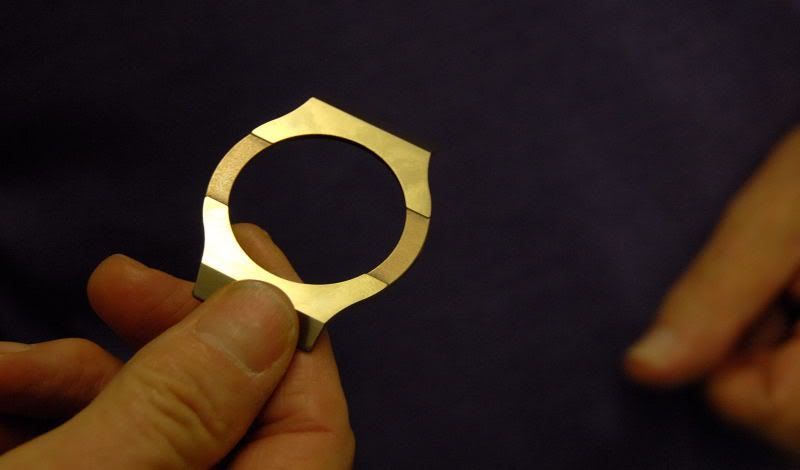
Okay – I’ll admit it – the press release did smack of Jean Claude Biver being a little over enthusiastic when he announced that here a new material based on a noble metal unchanged since the dawn of time: “A new astonishing material is born. A metal - that hasn’t change since the dawn of the earth – is benefiting from the latest high-technology. A revolution in the luxury industry.” Far reaching claims, and although I wonder if the extent of change is as Hublot claims, there is a new metal here that is the fusion of ceramic and 24 carat gold.
Despite the claims in the press release, by the end of the 3 hour press conference attended by a number of the world’s press, both watch related and otherwise, perhaps at last, Hublot does possess at their manufacture the ability to fuse different material (not normally associated with each other) at the molecular level. True fusion that goes beyond the parts of the case being made of different material parts; this is fusion in the material itself.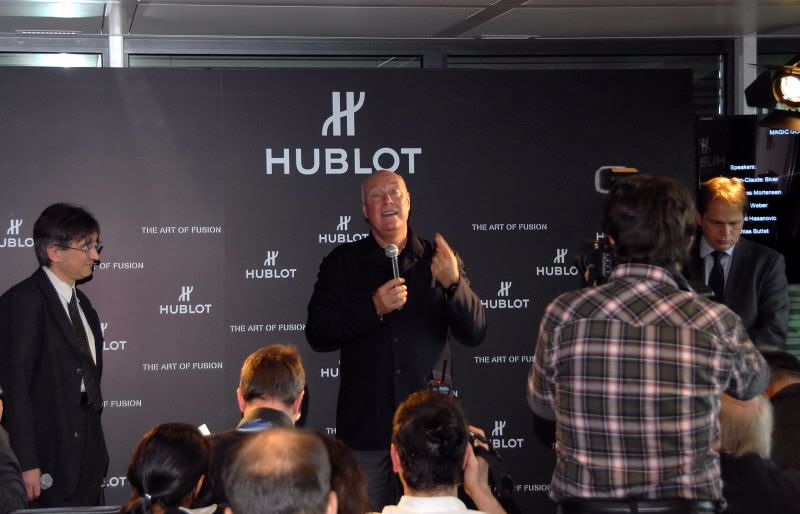
Not to say that Jean Claude’s enthusiasm was any less evident as he introduced the product and the team behind it. And here is where Hublot have scored. Jean Claude Biver and Hublot have produced an 18 carat gold that is a fusion of the true 24 carat gold and ceramic. This is not different parts made of different materials and bolted onto the watch case. No, this is fusion as the definition intended: to merge at the molecular level. This is new technology and a cutting edge process that Hublot have financed and invested in. The process and end product are all patented so you will not be seeing either product or process used by any other manufacturer in the near future.
The process and new metal are the result of Hublot material engineers working with scientists from the Ecole Polytechnique Federale de Lausanne (EPFL). The chief magician among them was Professor Andreas Mortensen from the EPFL Institute of Materials, Mechanical Metallurgy Laboratory. Not surprisingly the Hublot material engineers were previously students at EPFL and so the project grew out of known talents and connections between EPFL and Hublot. To produce this fusion so requires temperature and pressure that would have been cause for concern for even Prometheus himself. At 2200 degrees and under intense pressure gold and ceramic (normally not the two materials you would expect to be fused together) are forced into a single metal.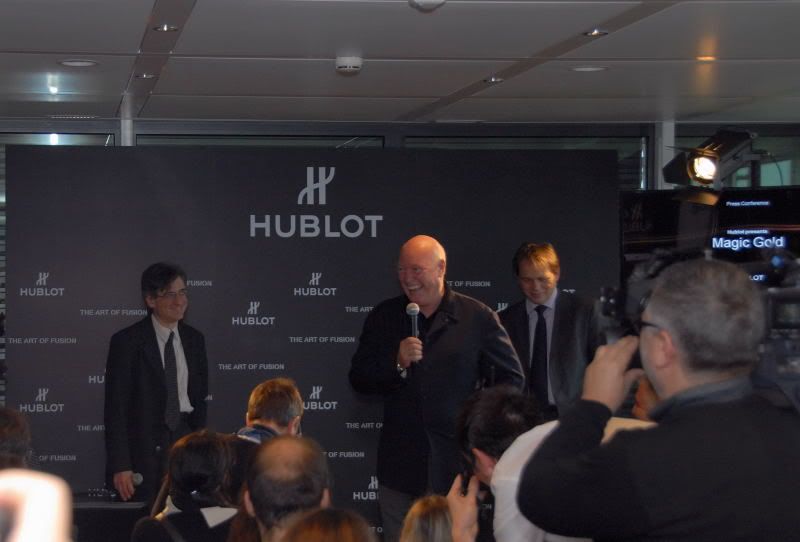
[Jean Claude Biver welcomes the world’s press and introduces ‘Magic Gold’]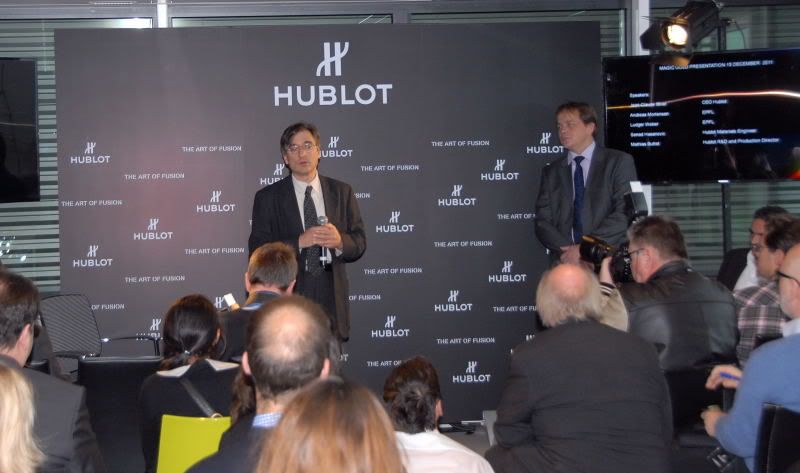
[Professor Andreas Mortensen introduces the elements of the process]
The world’s press was greeted by Jean Claude Biver in exuberant spirits, and playing some kind of latter day King Midas, told the story of how he believed he can touch the ceramic and it magically turns to gold! Understandably he calls the material ‘magic gold’. He introduced the court magicians and chief among them was Professor Andreas Mortensen. Professor Andreas Mortensen is a noted material and metallurgical scientist who conducts research at EPFL. About 3 years ago, Jean Claude Biver contacted Professor Andreas Mortensen and asked for a simple, but telling remit. Get me a fusion gold that could not be scratched, or dented, or have a need for a coating. The new process could not be a coating as Jean Claude Biver argued that a coating could wear off with time. It had to be done quickly and quietly. There is genuine research here. Professor Andreas Mortensen told me later that there will be published papers out of it in the future, and more to the point, there is a patent on both the process and the product. Professor Andreas Mortensen described the foundry that Hublot has built on the ground as being the envy of any high-tech company. It really is modern fusion metallurgy. 
[The Hublot material science team that worked with the EPFL scientists]
Although fusion alloys involving gold are well known, the difference here was that the gold alloy had to pass tests to be 18 carat gold. 18 carat gold has, according to Jean Claude Biver become the industry standard. Instead of using other alloys such as tin, or palladium, the magic gold uses ceramic boron carbide which is the third hardest material known to man. The process itself does fuse the two together. The ceramic particles are compressed into a space so that the material is just porous enough to allow molten gold to be pressured into the ceramic and in so doing create a liquid that is the fusion of both gold and ceramic. What makes the technology all the more desirable is the fact that this fusion process can be used with any other metals: be it aluminium, steel, or platinum.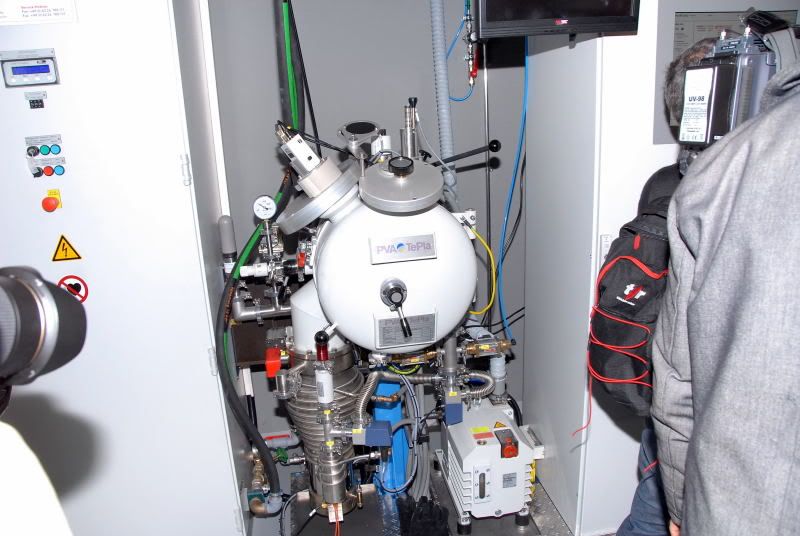
[The pressure cooker where 'magic gold' is fused]
The resulting new 18 carat ‘magic gold’ has a Vickers hardness equivalent to that of some of the hardest metal alloys known. The material itself is termed a metal matrix composite. The technical term for the new material is an interpenetrating phase composite (IPC) in which constituent phases form a homogeneously interconnected network. The porous ceramic creates a homogeneous phase distribution which promotes regularly distributed local shear deformation and leads to a uniform deformation for the composites. Moreover, the interpenetrating phase structure introduces a mutual-reinforcement between metallic gold and ceramic. In other words, the resulting material has a uniform and bonded molecular structure that makes it very resilient to any outward pressure.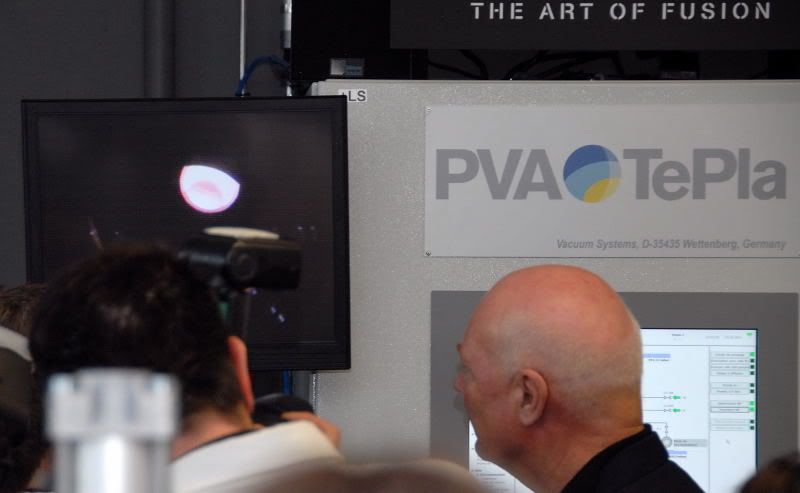
[Jean Claude Biver watching the Art of Fusion in real time: magic gold being created in the pressurised cauldron]
So what does this mean for the watch on your wrist? Well, primarily it means that a watch with a gold case does not have to worry about the scratch and ding problem to the same extent any more. The new ‘magic gold’, which is officially an 18 carat gold, has a composition of 75 percent gold, 22 percent boron carbide, and 3 percent aluminium. It is, without doubt, the toughest 18 carat gold ever created. As Jean Claude Biver went to great lengths to explain, the gold has a hardness of 1000 Vickers making it harder than most tempered steels. The material is almost impossible to scratch. If the surface finish is brushed , it stays brushed; if the finish is polished, it stays polished. The watch, even in 18 carat gold becomes a sports watch that can remain in the same condition as when it was bought. The only way the material can be shaped or cut is by using a diamond cutting tool.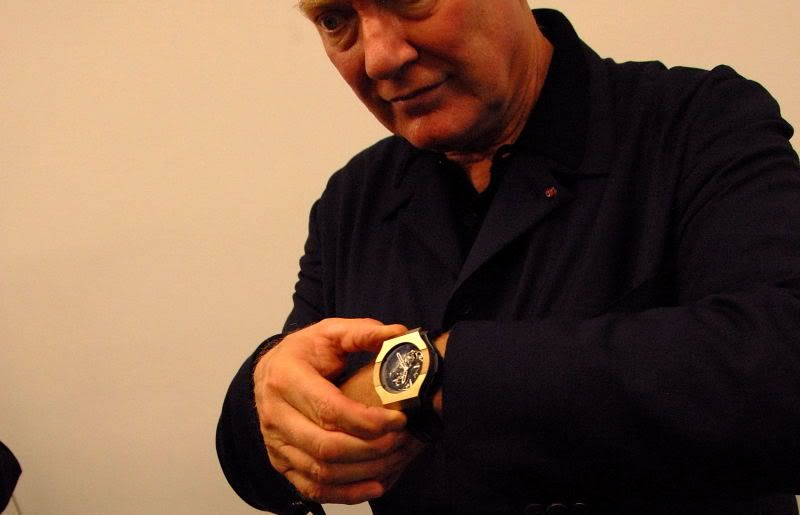
[Jean Claude Biver gives an idea of what the new ‘magic gold’ watch will look like on the wrist]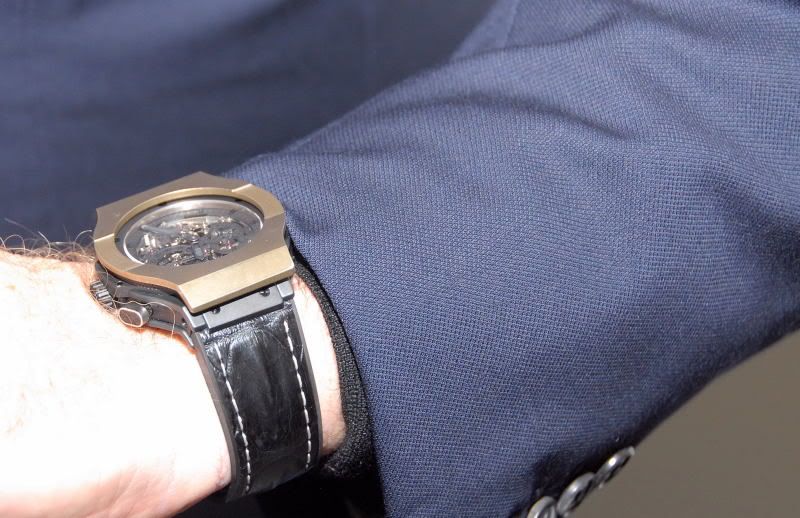
To manufacture magic gold Hublot have built their own foundry on-site. Professor Andreas Mortensen described it as the envy of any high-tech company. And being shown around the foundry by the ever enthusiastic Jean Claude Biver, you could see why. The machinery was new and the process slow. You can only produce a small amount of the gold on each run. There are basically five steps. The first step is to pack ceramic powders into a silicon mould, while pure gold (24 carat) is prepared for casting. The second step is to cold press the ceramic powder at 2000 bar of isostatic pressure to produce a compact preform. The third step is the sintering of the preform: the ceramic particles are bonded to one another at 2200 degrees Celsius and 100 millibar of gas pressure. At that pressure, the ceramic powder has a porous property that allows the molten gold to be squeezed through the porous ceramic. The fourth step is then to melt the pure gold (24 carat) at 1100 degrees Celsius and pouring the liquid metal into a mould. The fifth and final step in creating the 18 carat Magic Gold is by injecting the gold using 200 bar gas pressure at 1400 degrees Celsius into the sintered ceramic perform. 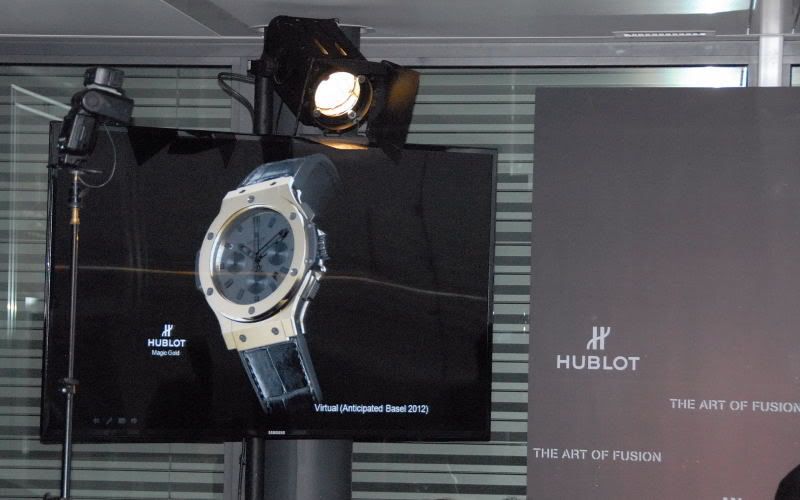
[Computer rendition of what the magic gold watch for Baselworld 2012 will look like]
The colour of the gold has yet to be decided as it can be tinted afterwards, but Jean Claude Biver assured the audience that the gold would have a unique colour to ensure it could be recognised as ‘Magic Gold’. I have to say that with this, Hublot have given themselves a jump in the market here. They have a unique metal for their watches. What remains to be seen is what Hublot do with the metal and what the market makes of it. Sure, it’s 18 carat gold, but one of the things we love about traditional 18 carat gold is the patina that can be wrought over time. Patina is something that comes from the testimony of time. So a watch that looks the same in 20 years time as it did the day you first strapped it to your wrist... perhaps not for me. I love the patina of old gold in the same way that I see the odd line appear around my wife’s eyes (not that I tell her). Part of life; part of the passage of time and growing old.
Still, what is impressive is the technology from Hublot and kudos to them for pushing the boundaries of material science.
Andrew H This message has been edited by KIH on 2011-12-18 15:48:26 This message has been edited by KIH on 2011-12-21 16:55:59

It’s a kind of magic! Hublot and the Art of Fusion creates ‘Magic Gold’.

Thanks a lot Andrew for this excellent post.

Thank you for ther full report. Andrew!

Alchemy?

Excellent question, Andrew.

Should be called Beverium (or are they saving that?)
haha funny

You were not alone, Mike ...
Hublonium

Yes indeed
Nice report Andrew!

Thank you for the additional info..
